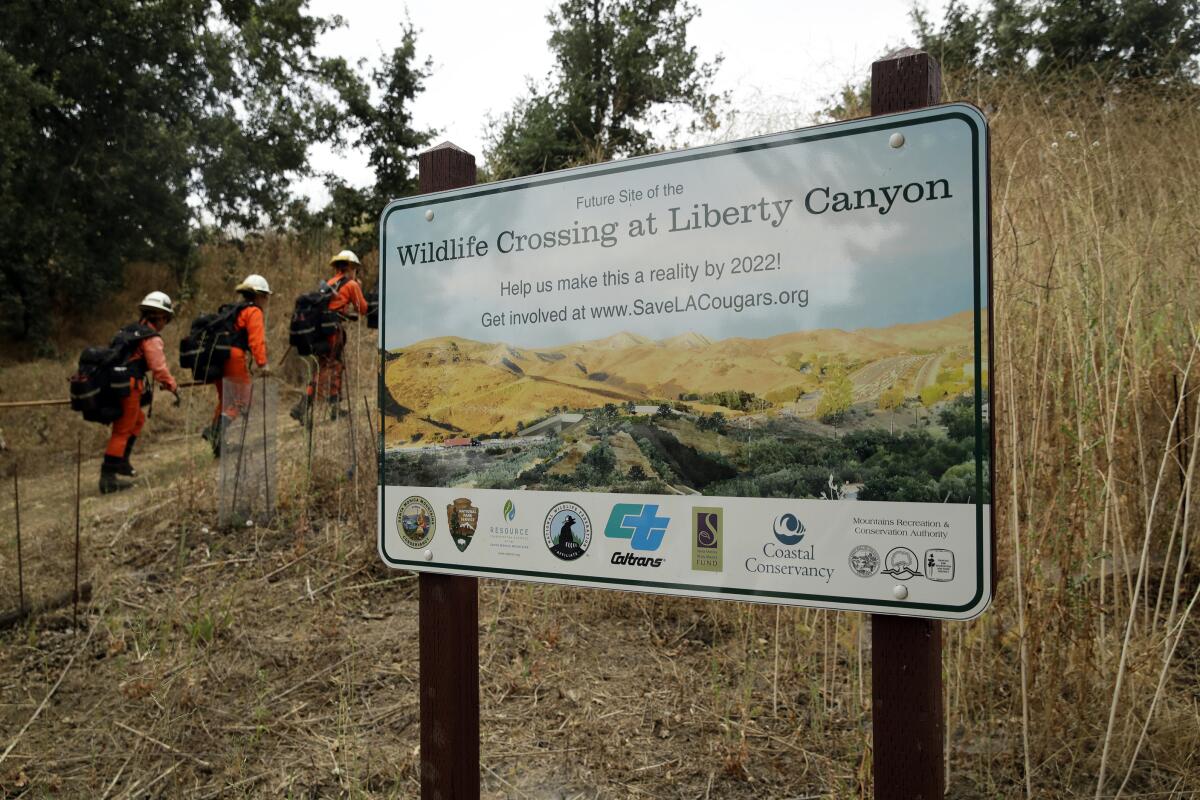Proposed Bay Area wildlife crossing is latest effort to save mountain lions, other animals

A first of its kind wildlife crossing in Northern California has been proposed over Highway 101 in San Benito County — the latest project in the state’s efforts to provide safe passage for mountain lions and other animals over dangerous roadways.
About $21 million has been raised to fund the overpass at 2,600-acre Rocks Ranch, the nonprofit Land Trust of Santa Cruz County announced earlier this year. The wildlife corridor would connect the Santa Cruz and Gabilan mountain ranges and expand the habitat for mountain lions, deer, bobcats and other animals.
“Wildlife needs a lot more than just isolated islands of habitats,” said Sarah Newkirk, the executive director of the nonprofit Land Trust of Santa Cruz County. “Habitat areas need to be connected to one another so that a wide-ranging species like mountain lions can get from place to place, establish new territories and enhance their genetic diversity.”
Development of the Bay Area is isolating the Santa Cruz Mountains, with a southern portion of the area divided by the highway, said Morgan Robertson, the acting chief of biology and environmental engineering for Caltrans District 5.
Animals do cross roadways using existing infrastructure, she said, but some species need sturdier and larger structures to pass safely.
According to a 2022 report by the California Department of Fish and Wildlife, about 150 areas in the state were identified as wildlife barriers. Most of these locations were near state highways.
“We can see from the movement of pumas and even bobcats that Highway 101 is almost a complete barrier to movement across the way,” said Chris Wilmers, a UC Santa Cruz professor of wildlife ecology and conservation and the director of the Santa Cruz Puma Project.
The northern end of the Rocks Ranch area, which runs alongside a 2.5-mile stretch of the highway, was identified as a hotspot for wildlife-vehicle collisions that injure and kill animals and people alike.
The Rocks Ranch overpass, which would allow animals to avoid the four lanes of speeding traffic, is in the initial stages, Robertson said. Caltrans will complete a feasibility study by the end of the year, and is considering both undercrossings and overpasses along the corridor. Construction is expected to start in 2029, she said.
The project follows the recent completion of an animal under crossing in the Santa Cruz Mountains on Highway 17 that was 10 years in the making. Now equipped with the playbook from the previous project, Newkirk said planning for the Highway 101 wildlife overpass will be much smoother.
“We didn’t really know what we were doing then,” Newkirk said. “Every step was effectively a leap of faith by the land trust and our partners. But now we know how to work with those agencies, and they’re excited to work with us.”
This is the first time a GPS-collared mountain lion has crossed the freeway near the Santa Monica Mountains during the course of a 17-year study.
Animal crossings are becoming more common throughout California in an effort by conservationists to decrease road kills and increase genetic diversity among wildlife living near freeways and residential developments.
The late P-22, a celebrity mountain lion that prowled around Griffith Park and beyond, inspired the need for animal crossings when it was discovered in 2012 that he regularly made a 20-mile journey from the Santa Monica Mountains, dodging commuter traffic, bridges and roads.
In 2014, the nonprofit #SaveLACougars campaign began raising money to build the Liberty Canyon Wildlife Crossing in Agoura Hills, which has since broken ground and is expected to open in 2025. It will be the largest wildlife corridor of its kind in the world.
A bridge for wildlife to safely cross the 101 Freeway. It could happen. The “Save L.A.
Roads, highways, and other developments cut habitats in half, preventing animals from safely traveling back and forth, Wilmers said. This can cause slower population growth, including issues related to malformed sperm and kinked tails, which make extinction more likely in the future.
Human interactions also affect species’ populations. From 2018 to 2020, more than 44,000 wildlife-vehicle collisions were reported on California roads resulting in human and animal deaths, and damage totaling about $1 billion, according to the UC Davis Road Ecology Center.
In Southern California, mountain lion populations have been steadily declining in the Santa Ana, San Gabriel, San Bernardino, Santa Monica, Santa Cruz and Tehachapi mountain ranges. Habitat fragmentation, disease, territorial battles, rodenticide poisoning, and human-caused wildfires have contributed to the decline.
Although mountain lions are not a threatened species in California, biologists argued in 2019 that six isolated and genetically distinct cougar clans found from the Santa Cruz to the U.S.-Mexico border make up a subpopulation that should be listed as endangered.
Other areas of California have proposed construction of wildlife bridges or tunnels. In Orange County, the Irvine-Laguna Wildlife Corridor would connect a national forest to wild coastal terrains.
“We knew that this needed to be done,” Newkirk said. “Tools are now in place, and the state has increasingly committed meaningful funding to get these projects done.”











